Economics Assignment: Monopoly Market Analysis and Case Study
VerifiedAdded on 2023/04/20
|13
|2298
|182
Essay
AI Summary
This economics assignment delves into the characteristics of a monopoly market, exploring its impact on price, quantity, and overall economic efficiency. The paper begins with an introduction to market structures, differentiating between perfectly competitive markets and imperfectly competitive ones, with a focus on monopolies. It then outlines the key features of a monopoly, including a single seller, lack of close substitutes, barriers to entry, and the ability to set prices. The analysis covers both short-run and long-run profit scenarios for a monopolist, illustrating how they can earn supernormal profits due to restricted competition. A significant portion of the assignment is dedicated to a case study of the Australian post, which is presented as an example of a legal monopoly. The discussion includes the reasons for its monopoly power, the obligations it must fulfill, and the impacts of its pricing strategies. The assignment also examines the inefficiencies inherent in a monopoly market, such as higher prices and lower output compared to a competitive market, leading to consumer surplus reduction and deadweight loss. Finally, the paper discusses the role of government intervention in controlling monopoly power, including measures to prevent excessive pricing, ensure quality of service, and address monopsony power and natural monopolies. The assignment concludes by summarizing the key features of a monopoly and highlighting the role of government in regulating such markets.
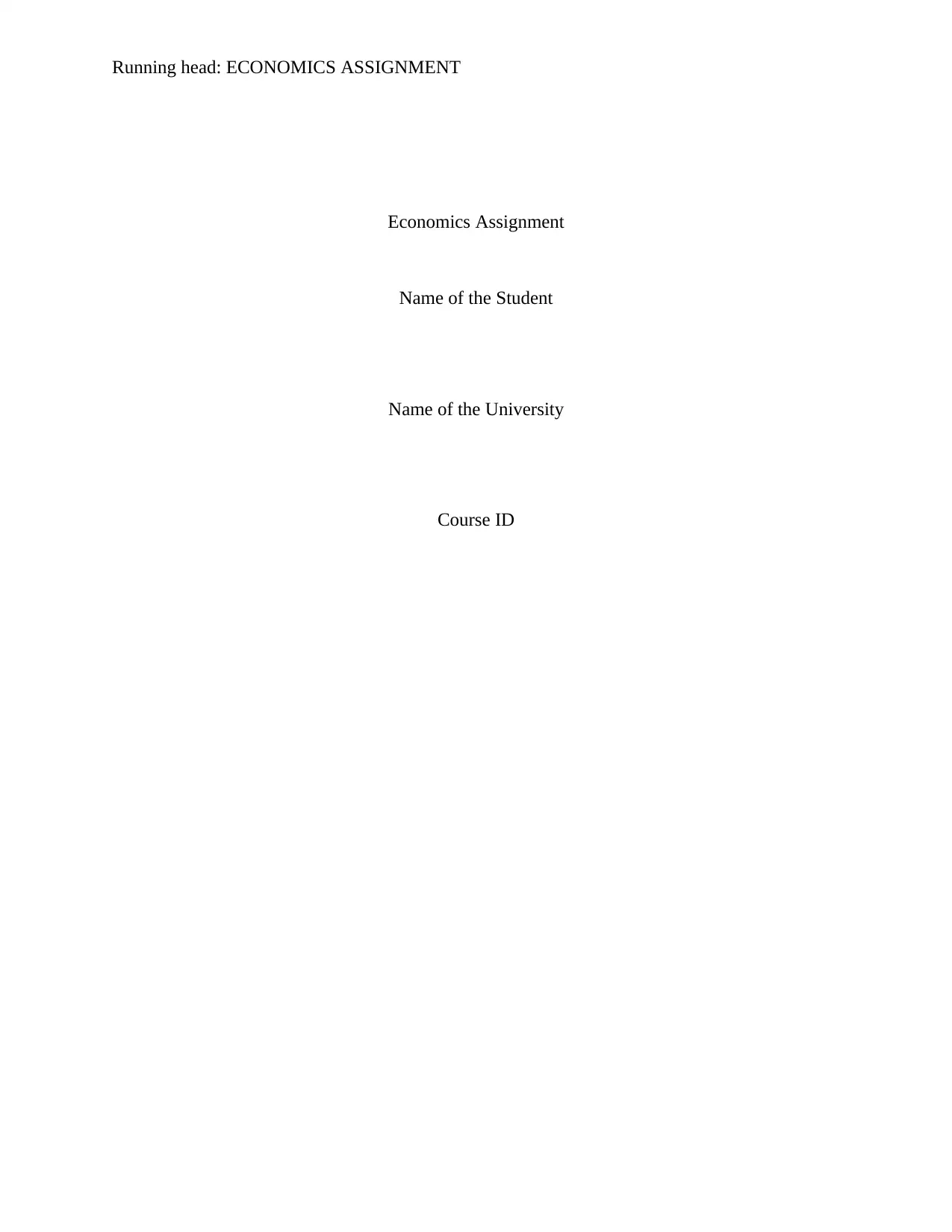
Running head: ECONOMICS ASSIGNMENT
Economics Assignment
Name of the Student
Name of the University
Course ID
Economics Assignment
Name of the Student
Name of the University
Course ID
Paraphrase This Document
Need a fresh take? Get an instant paraphrase of this document with our AI Paraphraser
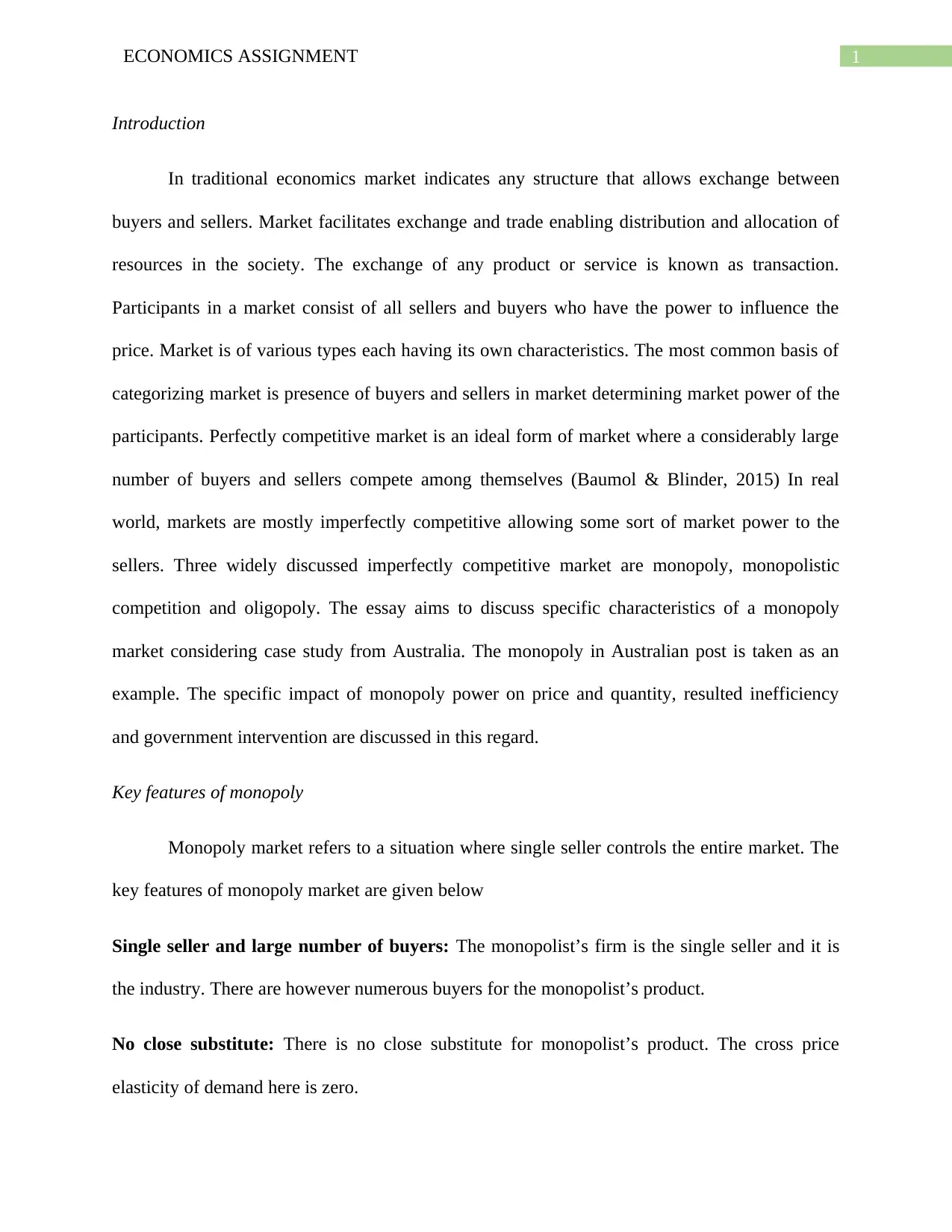
1ECONOMICS ASSIGNMENT
Introduction
In traditional economics market indicates any structure that allows exchange between
buyers and sellers. Market facilitates exchange and trade enabling distribution and allocation of
resources in the society. The exchange of any product or service is known as transaction.
Participants in a market consist of all sellers and buyers who have the power to influence the
price. Market is of various types each having its own characteristics. The most common basis of
categorizing market is presence of buyers and sellers in market determining market power of the
participants. Perfectly competitive market is an ideal form of market where a considerably large
number of buyers and sellers compete among themselves (Baumol & Blinder, 2015) In real
world, markets are mostly imperfectly competitive allowing some sort of market power to the
sellers. Three widely discussed imperfectly competitive market are monopoly, monopolistic
competition and oligopoly. The essay aims to discuss specific characteristics of a monopoly
market considering case study from Australia. The monopoly in Australian post is taken as an
example. The specific impact of monopoly power on price and quantity, resulted inefficiency
and government intervention are discussed in this regard.
Key features of monopoly
Monopoly market refers to a situation where single seller controls the entire market. The
key features of monopoly market are given below
Single seller and large number of buyers: The monopolist’s firm is the single seller and it is
the industry. There are however numerous buyers for the monopolist’s product.
No close substitute: There is no close substitute for monopolist’s product. The cross price
elasticity of demand here is zero.
Introduction
In traditional economics market indicates any structure that allows exchange between
buyers and sellers. Market facilitates exchange and trade enabling distribution and allocation of
resources in the society. The exchange of any product or service is known as transaction.
Participants in a market consist of all sellers and buyers who have the power to influence the
price. Market is of various types each having its own characteristics. The most common basis of
categorizing market is presence of buyers and sellers in market determining market power of the
participants. Perfectly competitive market is an ideal form of market where a considerably large
number of buyers and sellers compete among themselves (Baumol & Blinder, 2015) In real
world, markets are mostly imperfectly competitive allowing some sort of market power to the
sellers. Three widely discussed imperfectly competitive market are monopoly, monopolistic
competition and oligopoly. The essay aims to discuss specific characteristics of a monopoly
market considering case study from Australia. The monopoly in Australian post is taken as an
example. The specific impact of monopoly power on price and quantity, resulted inefficiency
and government intervention are discussed in this regard.
Key features of monopoly
Monopoly market refers to a situation where single seller controls the entire market. The
key features of monopoly market are given below
Single seller and large number of buyers: The monopolist’s firm is the single seller and it is
the industry. There are however numerous buyers for the monopolist’s product.
No close substitute: There is no close substitute for monopolist’s product. The cross price
elasticity of demand here is zero.
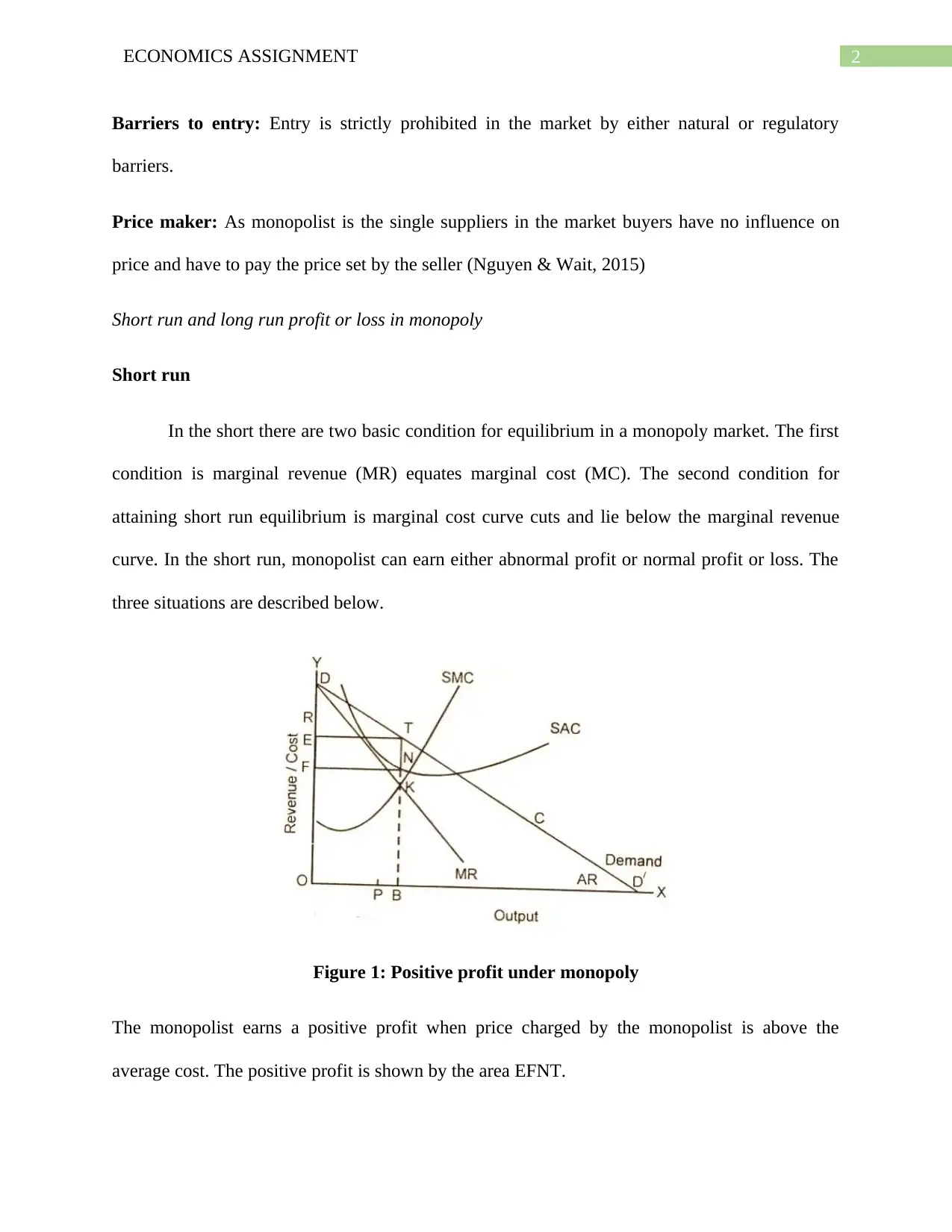
2ECONOMICS ASSIGNMENT
Barriers to entry: Entry is strictly prohibited in the market by either natural or regulatory
barriers.
Price maker: As monopolist is the single suppliers in the market buyers have no influence on
price and have to pay the price set by the seller (Nguyen & Wait, 2015)
Short run and long run profit or loss in monopoly
Short run
In the short there are two basic condition for equilibrium in a monopoly market. The first
condition is marginal revenue (MR) equates marginal cost (MC). The second condition for
attaining short run equilibrium is marginal cost curve cuts and lie below the marginal revenue
curve. In the short run, monopolist can earn either abnormal profit or normal profit or loss. The
three situations are described below.
Figure 1: Positive profit under monopoly
The monopolist earns a positive profit when price charged by the monopolist is above the
average cost. The positive profit is shown by the area EFNT.
Barriers to entry: Entry is strictly prohibited in the market by either natural or regulatory
barriers.
Price maker: As monopolist is the single suppliers in the market buyers have no influence on
price and have to pay the price set by the seller (Nguyen & Wait, 2015)
Short run and long run profit or loss in monopoly
Short run
In the short there are two basic condition for equilibrium in a monopoly market. The first
condition is marginal revenue (MR) equates marginal cost (MC). The second condition for
attaining short run equilibrium is marginal cost curve cuts and lie below the marginal revenue
curve. In the short run, monopolist can earn either abnormal profit or normal profit or loss. The
three situations are described below.
Figure 1: Positive profit under monopoly
The monopolist earns a positive profit when price charged by the monopolist is above the
average cost. The positive profit is shown by the area EFNT.
⊘ This is a preview!⊘
Do you want full access?
Subscribe today to unlock all pages.

Trusted by 1+ million students worldwide
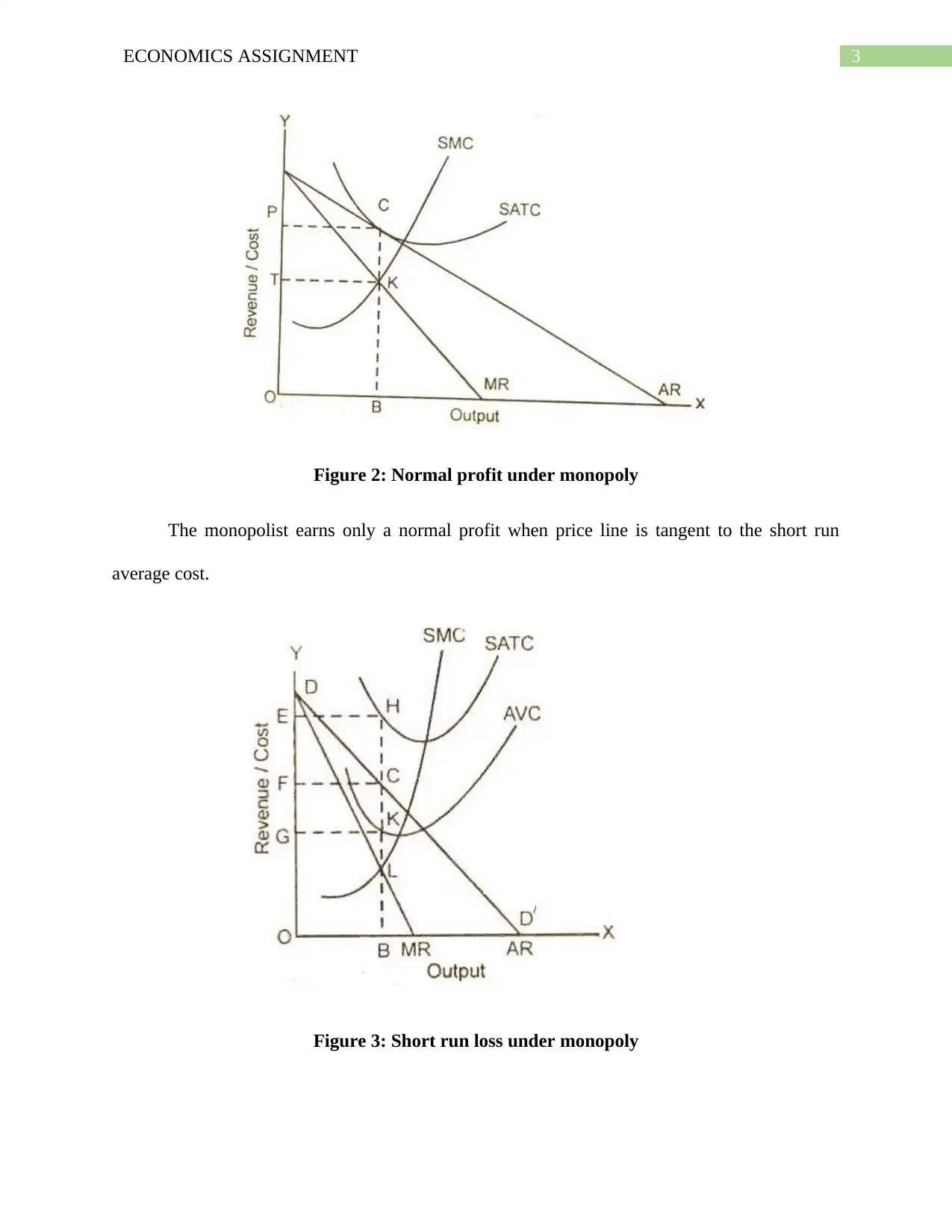
3ECONOMICS ASSIGNMENT
Figure 2: Normal profit under monopoly
The monopolist earns only a normal profit when price line is tangent to the short run
average cost.
Figure 3: Short run loss under monopoly
Figure 2: Normal profit under monopoly
The monopolist earns only a normal profit when price line is tangent to the short run
average cost.
Figure 3: Short run loss under monopoly
Paraphrase This Document
Need a fresh take? Get an instant paraphrase of this document with our AI Paraphraser
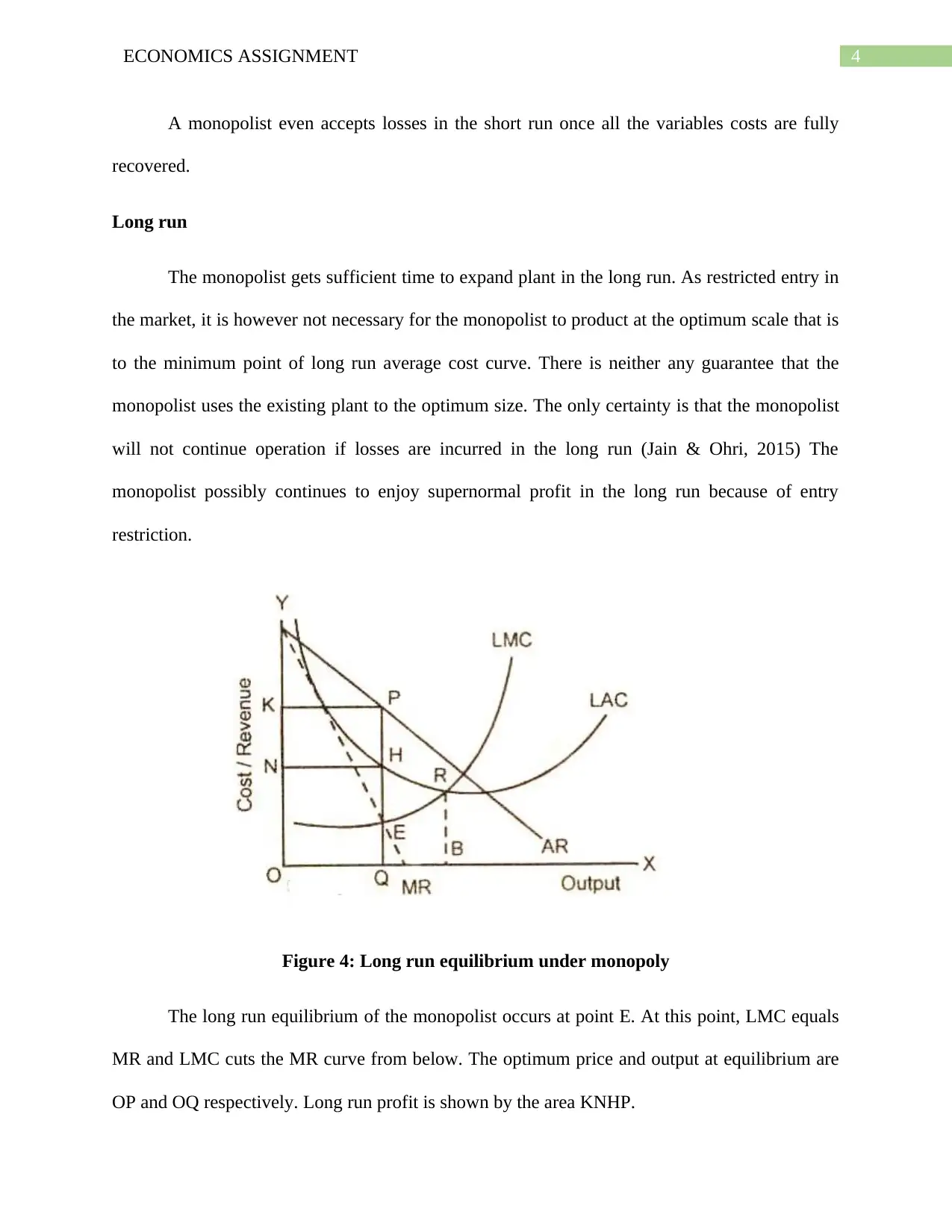
4ECONOMICS ASSIGNMENT
A monopolist even accepts losses in the short run once all the variables costs are fully
recovered.
Long run
The monopolist gets sufficient time to expand plant in the long run. As restricted entry in
the market, it is however not necessary for the monopolist to product at the optimum scale that is
to the minimum point of long run average cost curve. There is neither any guarantee that the
monopolist uses the existing plant to the optimum size. The only certainty is that the monopolist
will not continue operation if losses are incurred in the long run (Jain & Ohri, 2015) The
monopolist possibly continues to enjoy supernormal profit in the long run because of entry
restriction.
Figure 4: Long run equilibrium under monopoly
The long run equilibrium of the monopolist occurs at point E. At this point, LMC equals
MR and LMC cuts the MR curve from below. The optimum price and output at equilibrium are
OP and OQ respectively. Long run profit is shown by the area KNHP.
A monopolist even accepts losses in the short run once all the variables costs are fully
recovered.
Long run
The monopolist gets sufficient time to expand plant in the long run. As restricted entry in
the market, it is however not necessary for the monopolist to product at the optimum scale that is
to the minimum point of long run average cost curve. There is neither any guarantee that the
monopolist uses the existing plant to the optimum size. The only certainty is that the monopolist
will not continue operation if losses are incurred in the long run (Jain & Ohri, 2015) The
monopolist possibly continues to enjoy supernormal profit in the long run because of entry
restriction.
Figure 4: Long run equilibrium under monopoly
The long run equilibrium of the monopolist occurs at point E. At this point, LMC equals
MR and LMC cuts the MR curve from below. The optimum price and output at equilibrium are
OP and OQ respectively. Long run profit is shown by the area KNHP.
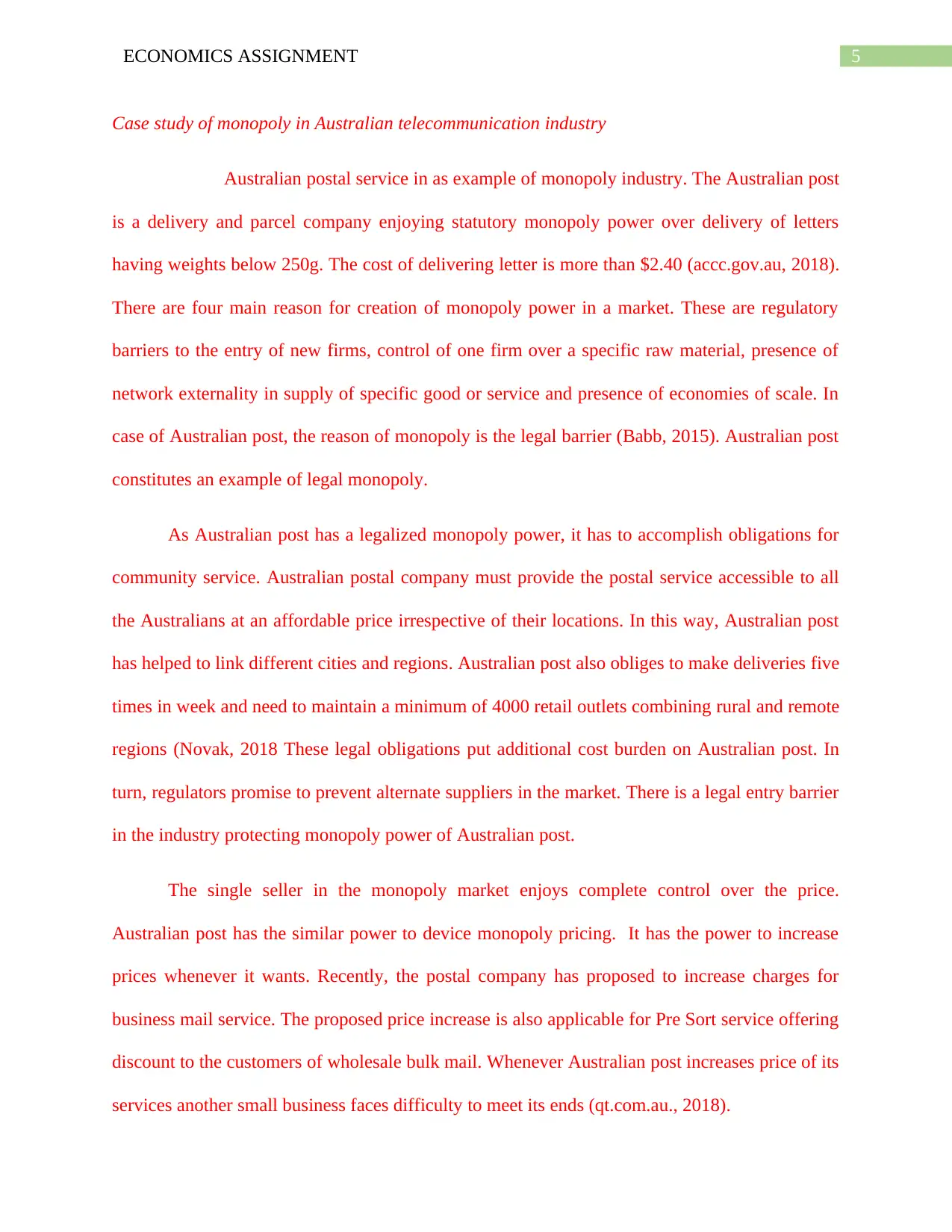
5ECONOMICS ASSIGNMENT
Case study of monopoly in Australian telecommunication industry
Australian postal service in as example of monopoly industry. The Australian post
is a delivery and parcel company enjoying statutory monopoly power over delivery of letters
having weights below 250g. The cost of delivering letter is more than $2.40 (accc.gov.au, 2018).
There are four main reason for creation of monopoly power in a market. These are regulatory
barriers to the entry of new firms, control of one firm over a specific raw material, presence of
network externality in supply of specific good or service and presence of economies of scale. In
case of Australian post, the reason of monopoly is the legal barrier (Babb, 2015). Australian post
constitutes an example of legal monopoly.
As Australian post has a legalized monopoly power, it has to accomplish obligations for
community service. Australian postal company must provide the postal service accessible to all
the Australians at an affordable price irrespective of their locations. In this way, Australian post
has helped to link different cities and regions. Australian post also obliges to make deliveries five
times in week and need to maintain a minimum of 4000 retail outlets combining rural and remote
regions (Novak, 2018 These legal obligations put additional cost burden on Australian post. In
turn, regulators promise to prevent alternate suppliers in the market. There is a legal entry barrier
in the industry protecting monopoly power of Australian post.
The single seller in the monopoly market enjoys complete control over the price.
Australian post has the similar power to device monopoly pricing. It has the power to increase
prices whenever it wants. Recently, the postal company has proposed to increase charges for
business mail service. The proposed price increase is also applicable for Pre Sort service offering
discount to the customers of wholesale bulk mail. Whenever Australian post increases price of its
services another small business faces difficulty to meet its ends (qt.com.au., 2018).
Case study of monopoly in Australian telecommunication industry
Australian postal service in as example of monopoly industry. The Australian post
is a delivery and parcel company enjoying statutory monopoly power over delivery of letters
having weights below 250g. The cost of delivering letter is more than $2.40 (accc.gov.au, 2018).
There are four main reason for creation of monopoly power in a market. These are regulatory
barriers to the entry of new firms, control of one firm over a specific raw material, presence of
network externality in supply of specific good or service and presence of economies of scale. In
case of Australian post, the reason of monopoly is the legal barrier (Babb, 2015). Australian post
constitutes an example of legal monopoly.
As Australian post has a legalized monopoly power, it has to accomplish obligations for
community service. Australian postal company must provide the postal service accessible to all
the Australians at an affordable price irrespective of their locations. In this way, Australian post
has helped to link different cities and regions. Australian post also obliges to make deliveries five
times in week and need to maintain a minimum of 4000 retail outlets combining rural and remote
regions (Novak, 2018 These legal obligations put additional cost burden on Australian post. In
turn, regulators promise to prevent alternate suppliers in the market. There is a legal entry barrier
in the industry protecting monopoly power of Australian post.
The single seller in the monopoly market enjoys complete control over the price.
Australian post has the similar power to device monopoly pricing. It has the power to increase
prices whenever it wants. Recently, the postal company has proposed to increase charges for
business mail service. The proposed price increase is also applicable for Pre Sort service offering
discount to the customers of wholesale bulk mail. Whenever Australian post increases price of its
services another small business faces difficulty to meet its ends (qt.com.au., 2018).
⊘ This is a preview!⊘
Do you want full access?
Subscribe today to unlock all pages.

Trusted by 1+ million students worldwide
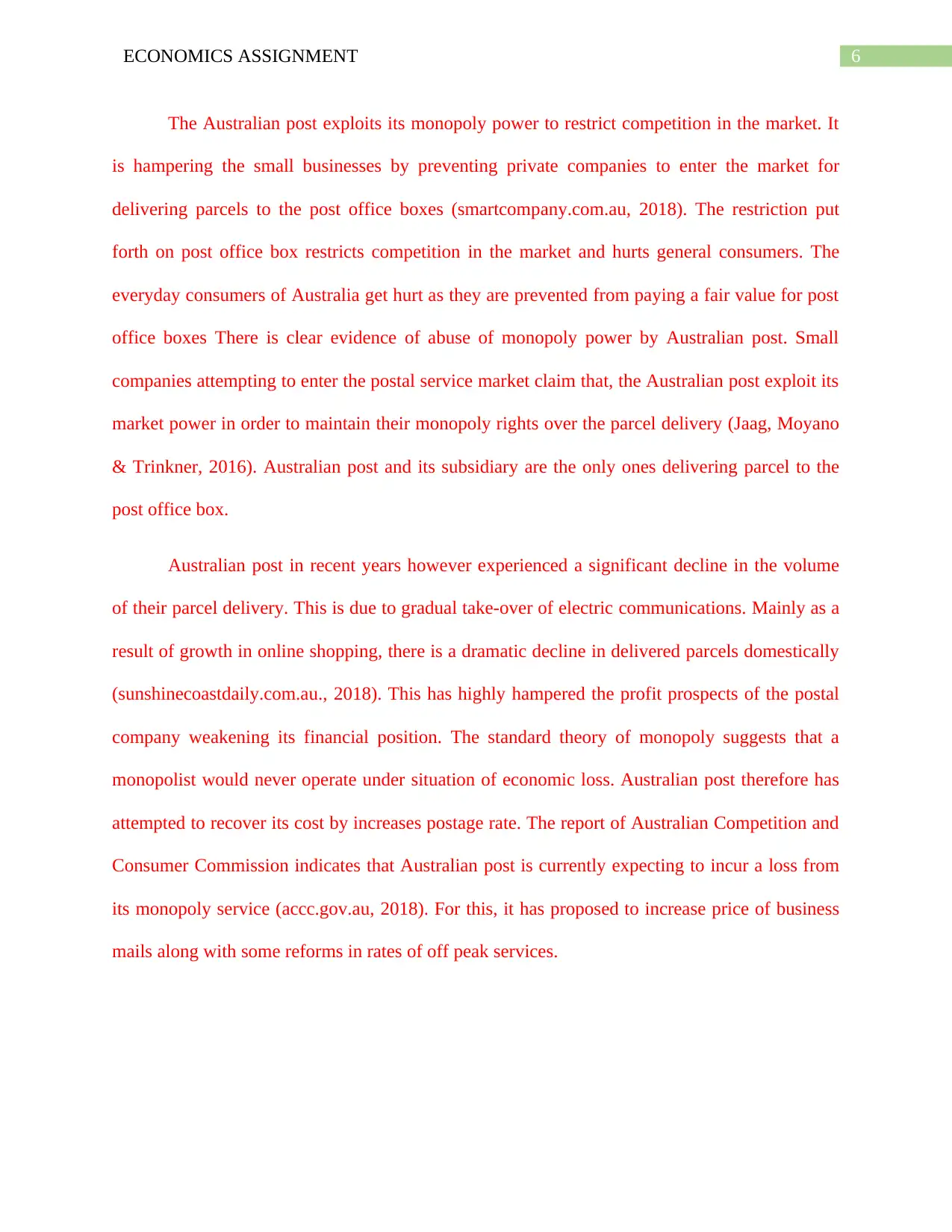
6ECONOMICS ASSIGNMENT
The Australian post exploits its monopoly power to restrict competition in the market. It
is hampering the small businesses by preventing private companies to enter the market for
delivering parcels to the post office boxes (smartcompany.com.au, 2018). The restriction put
forth on post office box restricts competition in the market and hurts general consumers. The
everyday consumers of Australia get hurt as they are prevented from paying a fair value for post
office boxes There is clear evidence of abuse of monopoly power by Australian post. Small
companies attempting to enter the postal service market claim that, the Australian post exploit its
market power in order to maintain their monopoly rights over the parcel delivery (Jaag, Moyano
& Trinkner, 2016). Australian post and its subsidiary are the only ones delivering parcel to the
post office box.
Australian post in recent years however experienced a significant decline in the volume
of their parcel delivery. This is due to gradual take-over of electric communications. Mainly as a
result of growth in online shopping, there is a dramatic decline in delivered parcels domestically
(sunshinecoastdaily.com.au., 2018). This has highly hampered the profit prospects of the postal
company weakening its financial position. The standard theory of monopoly suggests that a
monopolist would never operate under situation of economic loss. Australian post therefore has
attempted to recover its cost by increases postage rate. The report of Australian Competition and
Consumer Commission indicates that Australian post is currently expecting to incur a loss from
its monopoly service (accc.gov.au, 2018). For this, it has proposed to increase price of business
mails along with some reforms in rates of off peak services.
The Australian post exploits its monopoly power to restrict competition in the market. It
is hampering the small businesses by preventing private companies to enter the market for
delivering parcels to the post office boxes (smartcompany.com.au, 2018). The restriction put
forth on post office box restricts competition in the market and hurts general consumers. The
everyday consumers of Australia get hurt as they are prevented from paying a fair value for post
office boxes There is clear evidence of abuse of monopoly power by Australian post. Small
companies attempting to enter the postal service market claim that, the Australian post exploit its
market power in order to maintain their monopoly rights over the parcel delivery (Jaag, Moyano
& Trinkner, 2016). Australian post and its subsidiary are the only ones delivering parcel to the
post office box.
Australian post in recent years however experienced a significant decline in the volume
of their parcel delivery. This is due to gradual take-over of electric communications. Mainly as a
result of growth in online shopping, there is a dramatic decline in delivered parcels domestically
(sunshinecoastdaily.com.au., 2018). This has highly hampered the profit prospects of the postal
company weakening its financial position. The standard theory of monopoly suggests that a
monopolist would never operate under situation of economic loss. Australian post therefore has
attempted to recover its cost by increases postage rate. The report of Australian Competition and
Consumer Commission indicates that Australian post is currently expecting to incur a loss from
its monopoly service (accc.gov.au, 2018). For this, it has proposed to increase price of business
mails along with some reforms in rates of off peak services.
Paraphrase This Document
Need a fresh take? Get an instant paraphrase of this document with our AI Paraphraser
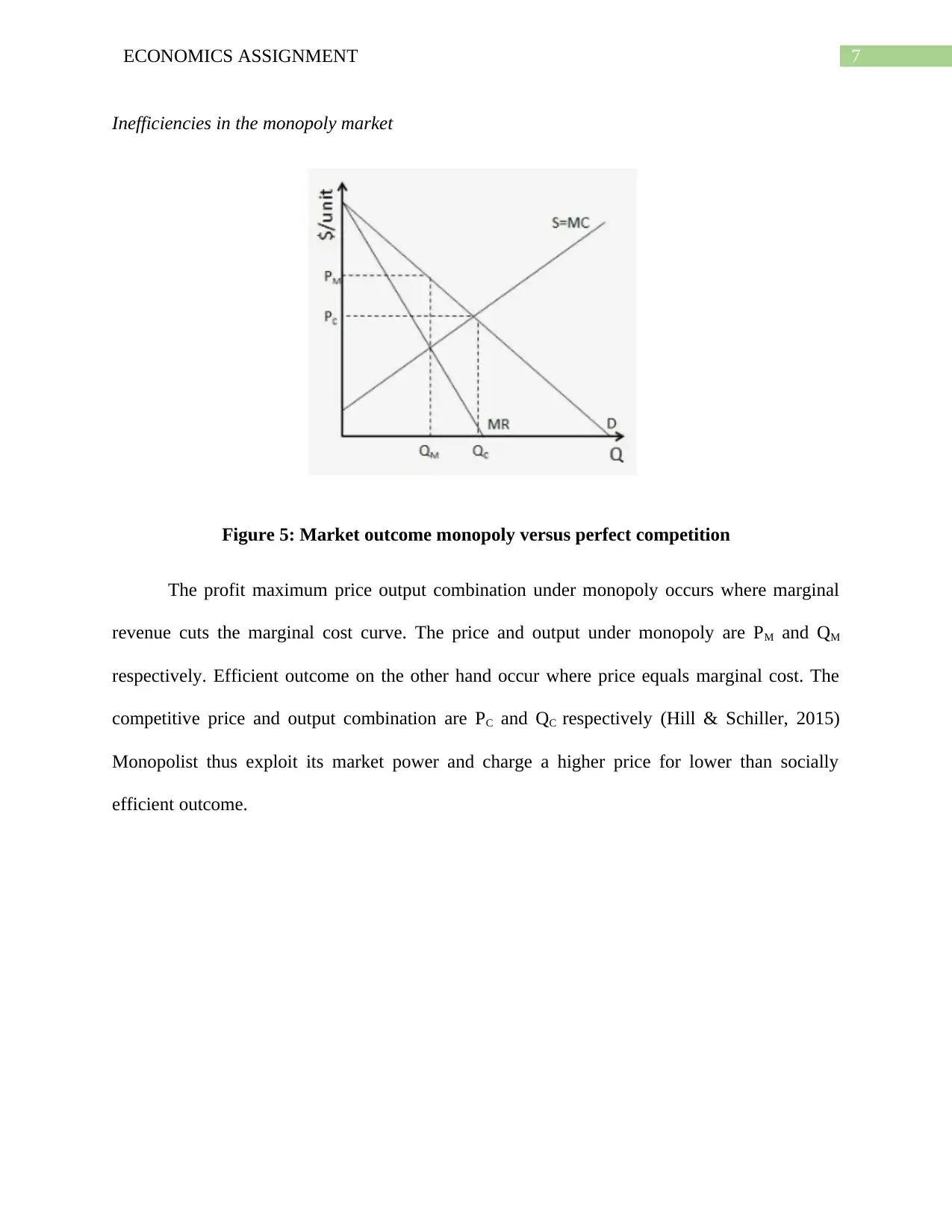
7ECONOMICS ASSIGNMENT
Inefficiencies in the monopoly market
Figure 5: Market outcome monopoly versus perfect competition
The profit maximum price output combination under monopoly occurs where marginal
revenue cuts the marginal cost curve. The price and output under monopoly are PM and QM
respectively. Efficient outcome on the other hand occur where price equals marginal cost. The
competitive price and output combination are PC and QC respectively (Hill & Schiller, 2015)
Monopolist thus exploit its market power and charge a higher price for lower than socially
efficient outcome.
Inefficiencies in the monopoly market
Figure 5: Market outcome monopoly versus perfect competition
The profit maximum price output combination under monopoly occurs where marginal
revenue cuts the marginal cost curve. The price and output under monopoly are PM and QM
respectively. Efficient outcome on the other hand occur where price equals marginal cost. The
competitive price and output combination are PC and QC respectively (Hill & Schiller, 2015)
Monopolist thus exploit its market power and charge a higher price for lower than socially
efficient outcome.
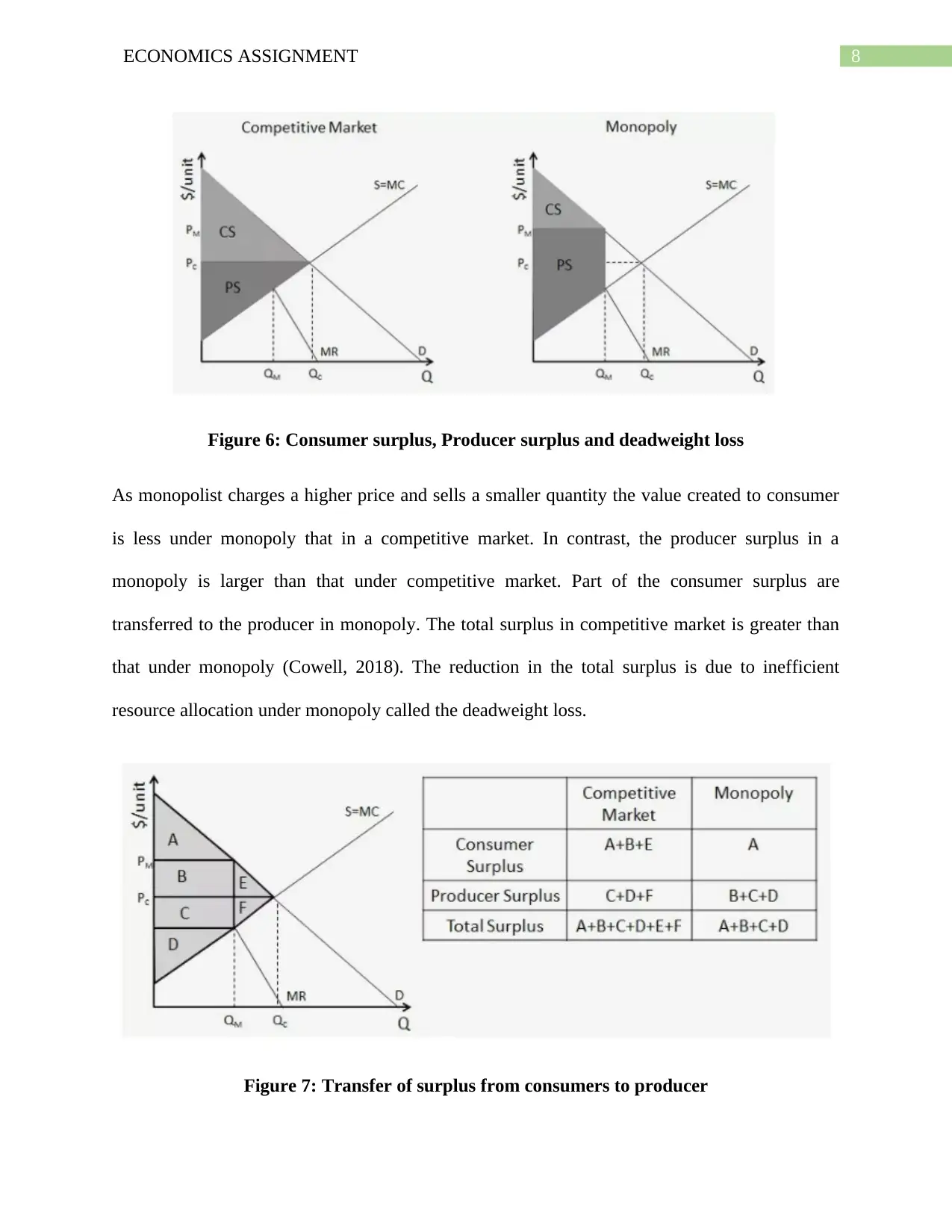
8ECONOMICS ASSIGNMENT
Figure 6: Consumer surplus, Producer surplus and deadweight loss
As monopolist charges a higher price and sells a smaller quantity the value created to consumer
is less under monopoly that in a competitive market. In contrast, the producer surplus in a
monopoly is larger than that under competitive market. Part of the consumer surplus are
transferred to the producer in monopoly. The total surplus in competitive market is greater than
that under monopoly (Cowell, 2018). The reduction in the total surplus is due to inefficient
resource allocation under monopoly called the deadweight loss.
Figure 7: Transfer of surplus from consumers to producer
Figure 6: Consumer surplus, Producer surplus and deadweight loss
As monopolist charges a higher price and sells a smaller quantity the value created to consumer
is less under monopoly that in a competitive market. In contrast, the producer surplus in a
monopoly is larger than that under competitive market. Part of the consumer surplus are
transferred to the producer in monopoly. The total surplus in competitive market is greater than
that under monopoly (Cowell, 2018). The reduction in the total surplus is due to inefficient
resource allocation under monopoly called the deadweight loss.
Figure 7: Transfer of surplus from consumers to producer
⊘ This is a preview!⊘
Do you want full access?
Subscribe today to unlock all pages.

Trusted by 1+ million students worldwide
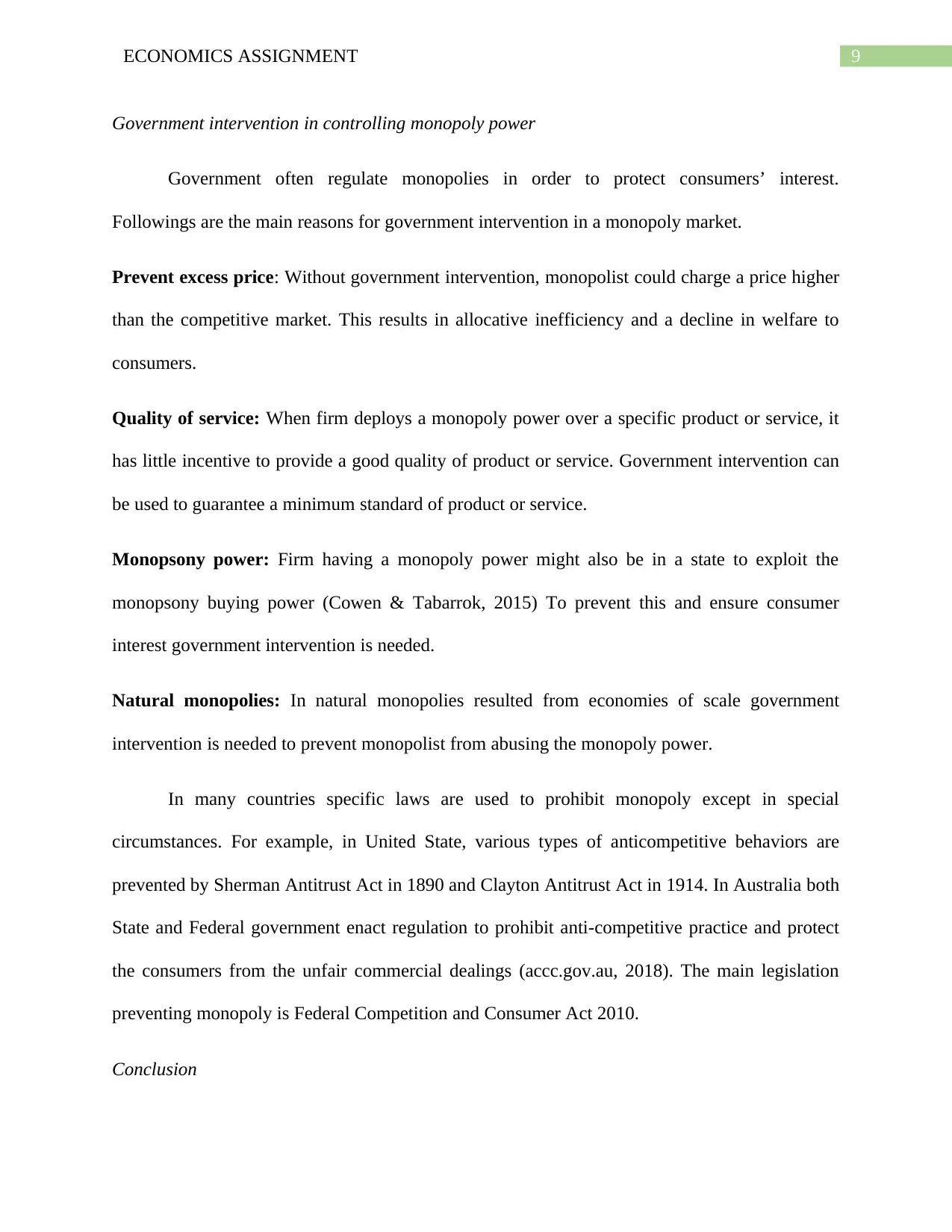
9ECONOMICS ASSIGNMENT
Government intervention in controlling monopoly power
Government often regulate monopolies in order to protect consumers’ interest.
Followings are the main reasons for government intervention in a monopoly market.
Prevent excess price: Without government intervention, monopolist could charge a price higher
than the competitive market. This results in allocative inefficiency and a decline in welfare to
consumers.
Quality of service: When firm deploys a monopoly power over a specific product or service, it
has little incentive to provide a good quality of product or service. Government intervention can
be used to guarantee a minimum standard of product or service.
Monopsony power: Firm having a monopoly power might also be in a state to exploit the
monopsony buying power (Cowen & Tabarrok, 2015) To prevent this and ensure consumer
interest government intervention is needed.
Natural monopolies: In natural monopolies resulted from economies of scale government
intervention is needed to prevent monopolist from abusing the monopoly power.
In many countries specific laws are used to prohibit monopoly except in special
circumstances. For example, in United State, various types of anticompetitive behaviors are
prevented by Sherman Antitrust Act in 1890 and Clayton Antitrust Act in 1914. In Australia both
State and Federal government enact regulation to prohibit anti-competitive practice and protect
the consumers from the unfair commercial dealings (accc.gov.au, 2018). The main legislation
preventing monopoly is Federal Competition and Consumer Act 2010.
Conclusion
Government intervention in controlling monopoly power
Government often regulate monopolies in order to protect consumers’ interest.
Followings are the main reasons for government intervention in a monopoly market.
Prevent excess price: Without government intervention, monopolist could charge a price higher
than the competitive market. This results in allocative inefficiency and a decline in welfare to
consumers.
Quality of service: When firm deploys a monopoly power over a specific product or service, it
has little incentive to provide a good quality of product or service. Government intervention can
be used to guarantee a minimum standard of product or service.
Monopsony power: Firm having a monopoly power might also be in a state to exploit the
monopsony buying power (Cowen & Tabarrok, 2015) To prevent this and ensure consumer
interest government intervention is needed.
Natural monopolies: In natural monopolies resulted from economies of scale government
intervention is needed to prevent monopolist from abusing the monopoly power.
In many countries specific laws are used to prohibit monopoly except in special
circumstances. For example, in United State, various types of anticompetitive behaviors are
prevented by Sherman Antitrust Act in 1890 and Clayton Antitrust Act in 1914. In Australia both
State and Federal government enact regulation to prohibit anti-competitive practice and protect
the consumers from the unfair commercial dealings (accc.gov.au, 2018). The main legislation
preventing monopoly is Federal Competition and Consumer Act 2010.
Conclusion
Paraphrase This Document
Need a fresh take? Get an instant paraphrase of this document with our AI Paraphraser
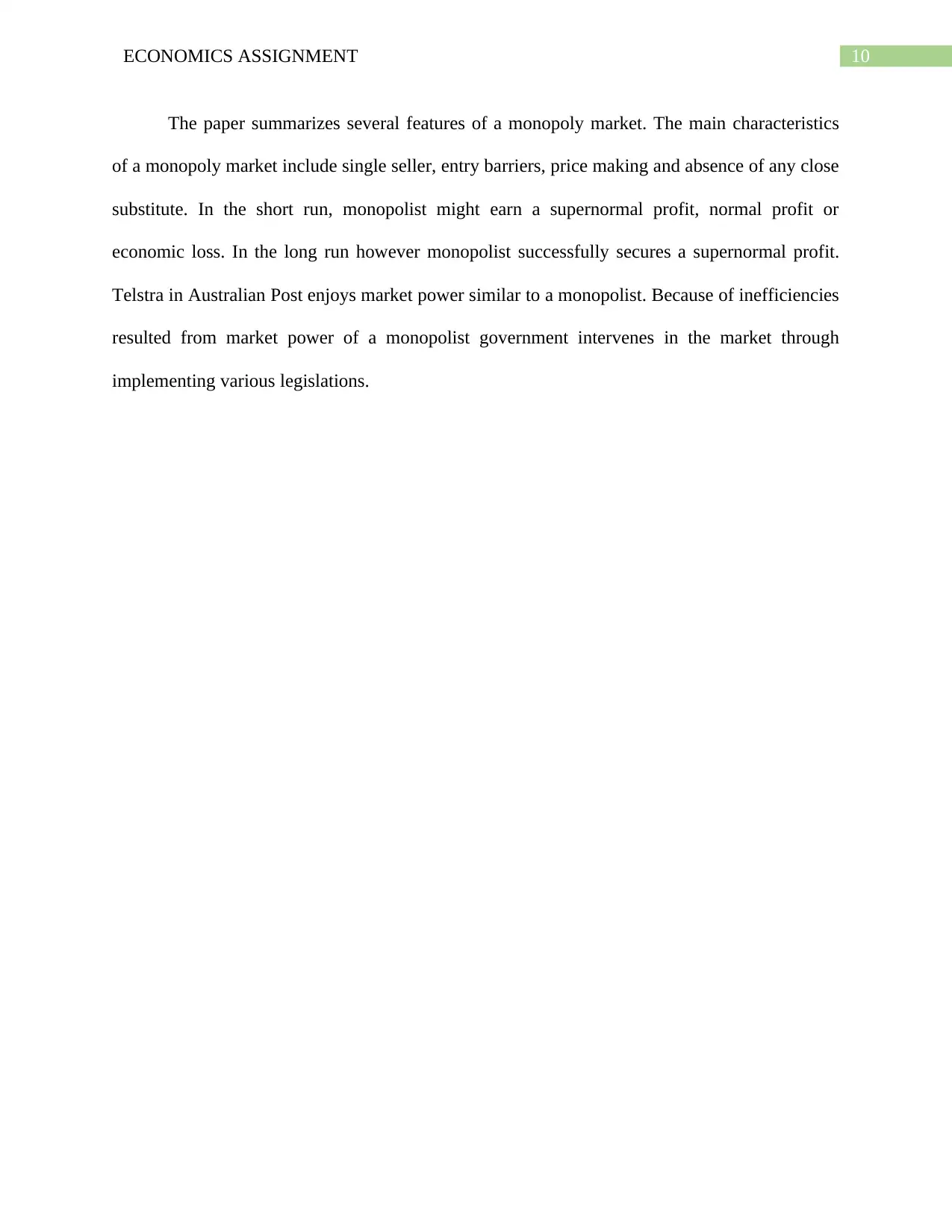
10ECONOMICS ASSIGNMENT
The paper summarizes several features of a monopoly market. The main characteristics
of a monopoly market include single seller, entry barriers, price making and absence of any close
substitute. In the short run, monopolist might earn a supernormal profit, normal profit or
economic loss. In the long run however monopolist successfully secures a supernormal profit.
Telstra in Australian Post enjoys market power similar to a monopolist. Because of inefficiencies
resulted from market power of a monopolist government intervenes in the market through
implementing various legislations.
The paper summarizes several features of a monopoly market. The main characteristics
of a monopoly market include single seller, entry barriers, price making and absence of any close
substitute. In the short run, monopolist might earn a supernormal profit, normal profit or
economic loss. In the long run however monopolist successfully secures a supernormal profit.
Telstra in Australian Post enjoys market power similar to a monopolist. Because of inefficiencies
resulted from market power of a monopolist government intervenes in the market through
implementing various legislations.
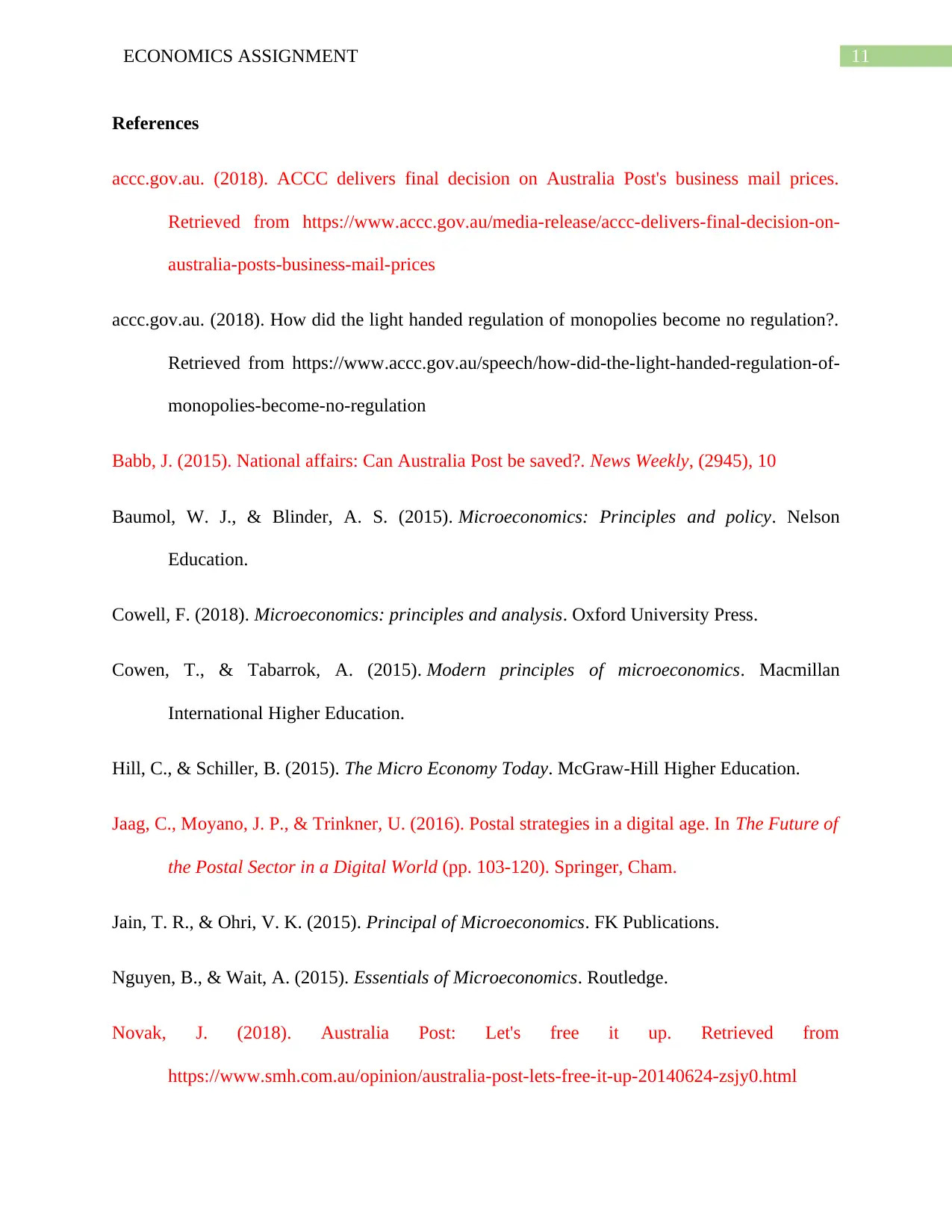
11ECONOMICS ASSIGNMENT
References
accc.gov.au. (2018). ACCC delivers final decision on Australia Post's business mail prices.
Retrieved from https://www.accc.gov.au/media-release/accc-delivers-final-decision-on-
australia-posts-business-mail-prices
accc.gov.au. (2018). How did the light handed regulation of monopolies become no regulation?.
Retrieved from https://www.accc.gov.au/speech/how-did-the-light-handed-regulation-of-
monopolies-become-no-regulation
Babb, J. (2015). National affairs: Can Australia Post be saved?. News Weekly, (2945), 10
Baumol, W. J., & Blinder, A. S. (2015). Microeconomics: Principles and policy. Nelson
Education.
Cowell, F. (2018). Microeconomics: principles and analysis. Oxford University Press.
Cowen, T., & Tabarrok, A. (2015). Modern principles of microeconomics. Macmillan
International Higher Education.
Hill, C., & Schiller, B. (2015). The Micro Economy Today. McGraw-Hill Higher Education.
Jaag, C., Moyano, J. P., & Trinkner, U. (2016). Postal strategies in a digital age. In The Future of
the Postal Sector in a Digital World (pp. 103-120). Springer, Cham.
Jain, T. R., & Ohri, V. K. (2015). Principal of Microeconomics. FK Publications.
Nguyen, B., & Wait, A. (2015). Essentials of Microeconomics. Routledge.
Novak, J. (2018). Australia Post: Let's free it up. Retrieved from
https://www.smh.com.au/opinion/australia-post-lets-free-it-up-20140624-zsjy0.html
References
accc.gov.au. (2018). ACCC delivers final decision on Australia Post's business mail prices.
Retrieved from https://www.accc.gov.au/media-release/accc-delivers-final-decision-on-
australia-posts-business-mail-prices
accc.gov.au. (2018). How did the light handed regulation of monopolies become no regulation?.
Retrieved from https://www.accc.gov.au/speech/how-did-the-light-handed-regulation-of-
monopolies-become-no-regulation
Babb, J. (2015). National affairs: Can Australia Post be saved?. News Weekly, (2945), 10
Baumol, W. J., & Blinder, A. S. (2015). Microeconomics: Principles and policy. Nelson
Education.
Cowell, F. (2018). Microeconomics: principles and analysis. Oxford University Press.
Cowen, T., & Tabarrok, A. (2015). Modern principles of microeconomics. Macmillan
International Higher Education.
Hill, C., & Schiller, B. (2015). The Micro Economy Today. McGraw-Hill Higher Education.
Jaag, C., Moyano, J. P., & Trinkner, U. (2016). Postal strategies in a digital age. In The Future of
the Postal Sector in a Digital World (pp. 103-120). Springer, Cham.
Jain, T. R., & Ohri, V. K. (2015). Principal of Microeconomics. FK Publications.
Nguyen, B., & Wait, A. (2015). Essentials of Microeconomics. Routledge.
Novak, J. (2018). Australia Post: Let's free it up. Retrieved from
https://www.smh.com.au/opinion/australia-post-lets-free-it-up-20140624-zsjy0.html
⊘ This is a preview!⊘
Do you want full access?
Subscribe today to unlock all pages.

Trusted by 1+ million students worldwide
1 out of 13
Related Documents
Your All-in-One AI-Powered Toolkit for Academic Success.
+13062052269
info@desklib.com
Available 24*7 on WhatsApp / Email
![[object Object]](/_next/static/media/star-bottom.7253800d.svg)
Unlock your academic potential
Copyright © 2020–2025 A2Z Services. All Rights Reserved. Developed and managed by ZUCOL.





